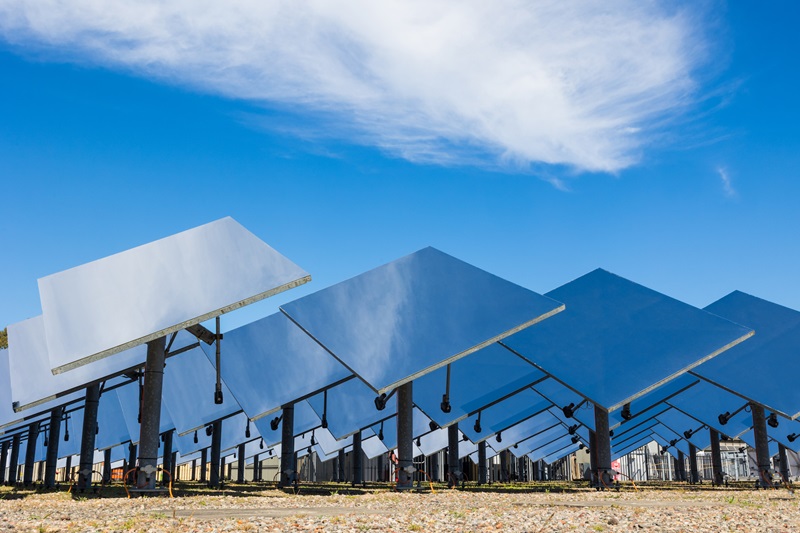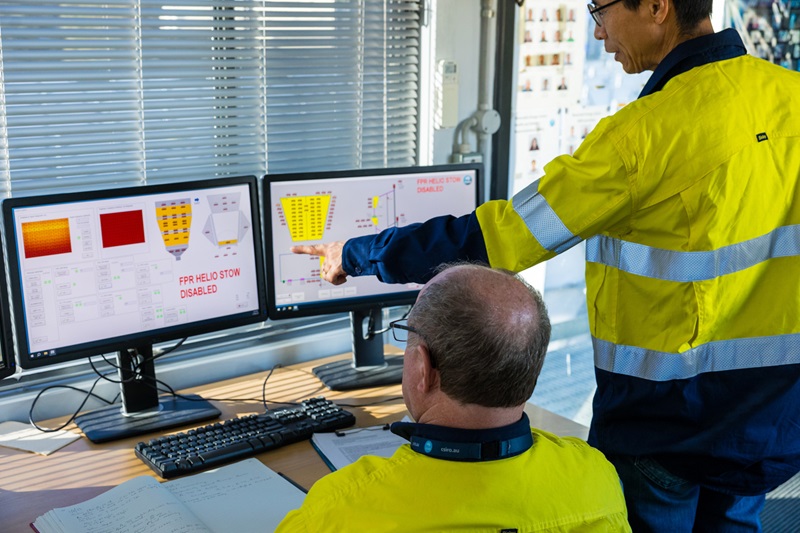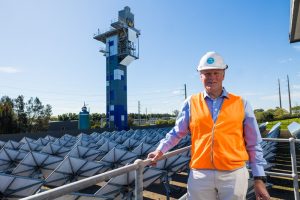Breakthrough solar thermal research is using ceramic particles that act like a battery, storing solar energy as heat. Concentrated solar thermal (CST) with ceramic particles offer a reliable, renewable power source that can be used even when the sun isn’t shining. This technology could play a key role in reducing industrial emissions, which currently account for 20 per cent of Australia’s energy use.
Wes Stein at our concentrating solar thermal research facility in Newcastle.
Despite Australia’s abundant solar energy resources, much of our electricity grid (about 67 per cent) is still powered by fossil fuels.
Climate change is hitting harder and decarbonisation is becoming more urgent. Meanwhile Australia’s sun-baked continent promises endless, net-zero energy – if only we can catch and store it. New developments in a reliable solar-based renewable energy technology, based on a centuries-old idea, could make this happen.
Now, our concentrated solar thermal research facility in Newcastle, New South Wales has announced a breakthrough as part of research investigating the potential of “falling ceramic particles” to capture and store solar energy as heat.
Reimagining the future of solar energy
Dr Jin-Soo Kim, who leads our solar technologies team, said the group recently achieved a critical milestone temperature of 803 °C for the first time at the falling particle receiver employing a new and novel concept.
«This is significant because it creates the opportunity for greater renewable energy storage when combined with our patented heat exchanger,» Jin-Soo said.
«This technology is key to delivering low-cost renewable energy at scale for the decarbonisation of Australia’s heavy industry.
«Over eight years of development and thousands of hours were invested to reach this outcome.»
If you’re thinking that sounds familiar, it’s because CST isn’t entirely new. The basic idea dates back to the 1800s when European inventors tinkered with sunlight concentration. In recent decades, several different concentrated solar thermal power technologies have evolved. They range from a parabolic dish circled by mirrors to tower systems filled with molten salt.
The game-changer today? Tiny ceramic particles, as fine as sand. Able to endure incredibly high temperatures, they’re ideal for storing significant amounts of heat.
These heated particles act like a battery, storing energy as heat, for up to 15 hours. As the particles cool, they release this energy. They could provide power whenever we need it, even at night and during periods of low solar and wind output.
Dominic Zaal is Director of the Australian Solar Thermal Research Institute (ASTRI).
«The technology is a smart, cost-effective way to store a large amount of high temperature heat for 10-15 hours,» Dominic said.

CSIRO’s solar thermal facility in Newcastle has 400 mirrors.
How falling ceramic particles are boosting Concentrated Solar Thermal (CST)
Wes Stein is our Chief Scientist for Solar Technologies and ASTRI’s Chief Technologist.
He said traditional CSTs are limited by the heat transfer fluids they use. Common fluids, like molten salt or high-temperature oil can only handle up to 600°C and 400°C, respectively.
However, the ceramic particles the team is working with can endure temperatures over 1000°C. These particles not only absorb the sun’s heat but also store it, simplifying the system and reducing costs.
The ‘falling’ part of this method uses gravity to heat these tiny, dark-hued ceramic particles. Each particle is less than half a millimetre in size. The particles are dropped from a hopper at the top of the tower, and heated as they pass through focused solar energy. In a short fall, their temperature can shoot from 500°C to 800°C, and with more advanced setups, possibly over 1000°C.
Unlike traditional methods that rely on steel tubes, the particles fall freely. This approach avoids the heat limitations of steel. Once heated, they’re stored in a silo. When needed, they’re used to produce steam for power generation or other industrial tasks.
While successful, developing the process was not without its own challenges. When particles fell too fast, they spread out. This let sunlight through and reduced efficiency. The answer was a ‘catch and release’ method. After falling a short distance, particles land in a trough, slowing them before they were allowed to fall into the next trough.
How CST can help us decarbonise
Australia’s growing use of solar and wind energy has fast-tracked the closure of many old coal-fired power stations. Forced to operate continuously, these stations still can’t match the affordability of daytime solar power, also known as photovoltaic (PV) solar energy.
And CST hasn’t set out to compete with it either.
“CST doesn’t compete with PV solar energy,” Dominic said.
“PV gives you power when the sun is shining, whereas CST takes energy from the sun, stores it and then allows the user to use that energy when the sun isn’t shining, such as overnight or on cloudy days.”
It’s a match made in heaven. CST with ceramic particles can offer a dependable and green power source. And its urgently needed, as 62 per cent of Australia’s coal-fired power stations are now expected to close before 2033.
CSIRO’s pilot system in Newcastle has 400 mirrors. However, a full-scale one might use over 10,000 larger mirrors. These can generate power similar to a 100 MW coal plant.
“The challenge isn’t so much collecting energy from the sun; it’s how to safely and efficiently convert that energy into heat and store it for later use,” Wes said.
“The power generation from CST technology resembles a coal-fired power plant without the coal. It uses the same turbine.
“Typical coal fired power plants use a steam turbine that operates at 540 degrees. Instead of using coal to create the heat to superheat the steam, we capture energy from the sun and store it for 10 to 15 hours.”
A roundup of CST projects globally reports 6460 megawatts (MW) of projects currently operational in 18 different countries, with another 3859 MW of projects under construction.
CST can help power industrial decarbonisation
Australia’s net-zero transition must include pathways for industrial decarbonisation. Dominic said our new falling ceramic particle technology will expand the role that CST can play in this mix.
“Process heat is the thermal energy used in industrial processes. And it accounts for over 20 per cent of Australia’s total energy use and emissions. There is now strong industry interest in how to abate thermal emissions,” Dominic said.

Falling ceramic particle technology could play a key role in industrial decarbonisation.
ASTRI has a CST case study underway, with pet-food manufacturer Mars. Mars has a pet-food processing plant based in Albury-Wodonga that uses more than 140 terajoules of gas annually.
The company is evaluating the potential installation of a CST system to provide renewable steam for their petfood manufacturing processes. It has the potential to displace up to 50 per cent of their gas usage.
Another system is currently installed at Mars Petcare Wodonga. It uses solar PV during the day to generate and store renewable heat. This system is currently providing 10 per cent of the plant’s energy, with plans to quickly increase to 40 per cent. Combining this PV system with the proposed CST system, Mars Petcare Wodonga is targeting net-zero operation by the end of 2025.
The estimated return on investment is over 10 years. Mars, which is a privately-owned family company, is strongly committed to net zero across all of its global operations by 2040.
«Within five years, the return on investment for this kind of renewable heat solution will be under 10 years. By 2035, the payback will be less than four to five years,” Dominic said.
«We need policies to encourage industry first-movers to establish local supply chains and expertise, thereby accelerating the energy transition. We want Australian industry to optimise their access to our abundant, low-cost solar resources. It will drive productivity and improve their competitive standing in global and domestic markets.»
Gas is considered to have relatively low carbon intensity (compared with coal). However, rising gas costs, reductions in CST costs, and the drive to decarbonise may shift this.
“The CSIRO CST falling particle technology can provide renewable heat at the same high temperature that coal and gas deliver, and over multiple hours,» Dominic said.
«In addition to being an ideal technology to replace current fossil-fuel based power generation assets, it is also an excellent technology to meet higher temperature requirements for mineral processing.»
With significant infrastructure support, falling particle CST could potentially account for up to 40 per cent of Australia’s electricity generation and process heat requirements in remote areas by 2050.
“This would make a significant contribution to Australia’s emissions reduction targets and help us to achieve a more sustainable energy future,” Dominic said.
CSIRO’s falling particle technology is being featured at the SolarPACES 2023 conference in Sydney.



